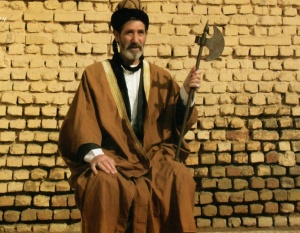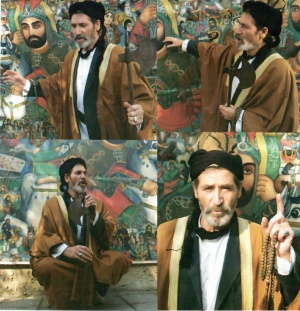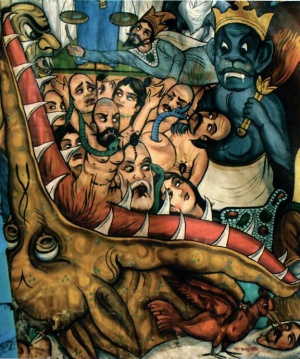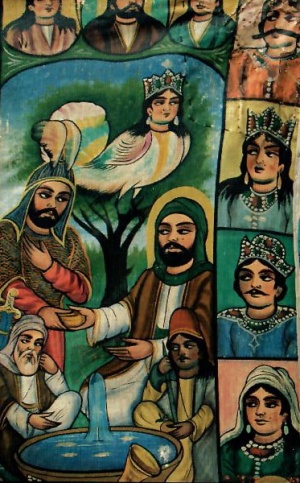Zabihollah bahari: Difference between revisions
T.ramezani (talk | contribs) (Created page with "{{Infobox artist | name = Zabihollah bahari | image = Zabihollah bahari 5.jpg | image_size = | alt = | caption = | birth...") |
mNo edit summary |
||
| Line 13: | Line 13: | ||
| patrons = Khan Ali Bahari (his father) and Morad Ali Bahari (his grandfather) | | patrons = Khan Ali Bahari (his father) and Morad Ali Bahari (his grandfather) | ||
}} | }} | ||
[[ذبیح الله بهاری]] | |||
'''Zabihollah Bahari''' (born in 1947) is a distinguished [[Pardekhan]] who started Pardekhani since the age of seven. He was trained by Khan Ali Bahari (his father) and Morad Ali Bahari (your grandfather). His performance is based on sung poetry and spoken prose. | '''Zabihollah Bahari''' (born in 1947) is a distinguished [[Pardekhan]] who started Pardekhani since the age of seven. He was trained by Khan Ali Bahari (his father) and Morad Ali Bahari (your grandfather). His performance is based on sung poetry and spoken prose. | ||
==Performance Method== | ==Performance Method== | ||
Revision as of 14:17, 14 July 2019
Zabihollah bahari | |
|---|---|
 | |
| Born | 1947 Borujerd |
| Nationality | Iranian |
| Known for | Pardekhani |
| Patron(s) | Khan Ali Bahari (his father) and Morad Ali Bahari (his grandfather) |
ذبیح الله بهاری Zabihollah Bahari (born in 1947) is a distinguished Pardekhan who started Pardekhani since the age of seven. He was trained by Khan Ali Bahari (his father) and Morad Ali Bahari (your grandfather). His performance is based on sung poetry and spoken prose.
Performance Method
He uses detailed but limited play movements which are the specific characteristic of curtain-storytellers; therefore, the theatrical actions in his performance are more abstract and symbolic in proportion to traditional performance. Picture-storytelling includes the greeting, advice and sermon, explanation of the curtain (pardeh), narration of the story, tangent (goriz) .... and these can be found in his performance in a determined way. These movements can be divided into two categories: general and particular motions. The first one includes turns in different directions, towards the curtain for the narration, towards the audience to gain attention, respect and exchange of emotion, towards the sky to express non-terrestrial concepts and towards the earth to remind of transitory life. The second one is the particular motions such as indicating the far distance, clapping or putting the hand behind the ear, use of the cane and hand to indicate different characters, places, times, feelings and situations, etc. The most important characteristic of Zabihollah' Bahari's performance is his being able in his transformations of emotions with the fewest movements by which the variety, mastery and knowledge of his performance can be seen.
Reciting Method
His singing at first creates the general atmosphere of Bayat e Tork with words Besmellah ... [1] and this becomes extreme with Dishab be saram baz ... The singer narrator, in the hemistich of Har kas ke bar in selseleye pak ... keeping within the same beginning maqam or mode, ascends a few notes and based on the meaning of the Sung poetry, he approaches the Gushe ye Hesar. [2] He continues in the same way and then in repeated performing of Ba al e Ali... he pauses on the last note of the first maqam (which we supposed was near Avaz -e Bayat-e Tork).
Transition out of Physical Time
Morshed Zabihollah Bahari indicates the life before death and afterlife of the curtain portraits such as Nasrani girl, Shimr and the old man who lives off usury. A little later the audience sees the result of actions of the evil doers. The Nasrani girl who falls in love with Imam Ali in her dream is illustrated in a heavenly frame. The usurer is shown with a snake coming out of his stomach. The pious believers are never in doubt about the compensation of the actions of this world in the other world. This is made possible with a transition beyond present and physical time. Creating the belief that it is possible to enter a distant time in an objective way is one of the important tools of curtain-storytelling.
Source
Ardalan, hamidreza (2008). Picture-storyteller masters of Iran, the Iranian academy of the art, 2008, volume 18. ISBN: 978-964-2986-057(vol.18). 978-964-2986-002(set).
Reference
- ↑ The curtain-narrator recites the second note of the first Dong a quarter tone lower than the Avaz e Bayat e Tork which causes the appearance of intervals which are unfamiliar to Iranian Dastgah music, but in terms of the melodic modulation and performance method it can be associated with Avaz e Bayat e Tork.
- ↑ Hesar (which means a restraining with which one is challenged) is performed in the Chargah and Mahur mode. The performance of this Gushe is different in terms of intervals and the Shahed note in the mentioned Dastgahs, and is similar in terms of musicality and rhythmic figures and expression. What is intended by Hesar in the performance of Zabihollah Bahari is the second meaning of this Gushe.



